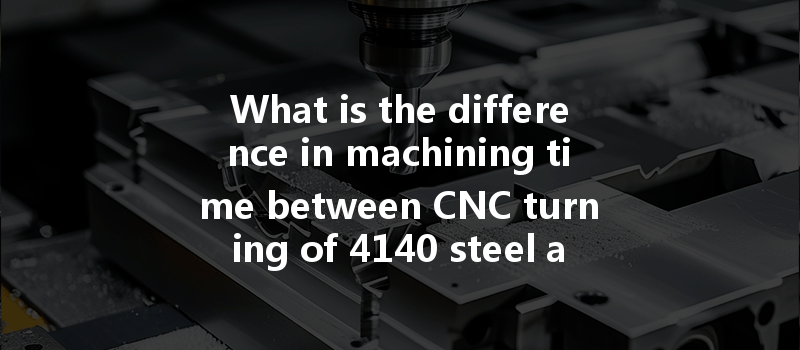Did you know that nearly 80% of the manufacturing costs in machining can be attributed to the time spent during processing? In the realm of CNC (Computer Numerical Control) machining, the differences between materials can significantly impact not just the quality of the finished product, but also the time and cost of production. This raises an important question for manufacturers and engineers alike: What is the difference in machining time between CNC turning of 4140 steel and 1045 steel?
In this blog, we will delve deeply into this intriguing topic and provide comprehensive insights into the factors that influence machining time, the technical specifications of both steel types, and strategic solutions to optimize CNC machining processes. Whether you are a seasoned machinist or a newcomer to the field, understanding how material characteristics affect machining performance is crucial for efficient operations.
The Fundamentals of CNC Machining
Before we explore the specifics of 4140 steel and 1045 steel, let’s quickly cover the basics of CNC machining. CNC machining involves the automated control of machine tools via a computer. This technique enables high precision and can work with a wide range of materials, from metal and plastic to wood and composites. The fundamental steps in CNC machining include design, programming, setup, and machining, ultimately leading to the finished part.
The Importance of Material Selection
Material selection is paramount in CNC machining, as different materials possess unique properties that can affect machining efficiency. Properties like hardness, toughness, tensile strength, and thermal conductivity can influence the cutting tools used, the cutting speeds applied, and the overall machining time required to achieve the desired tolerances and surface finishes.
Overview of 4140 Steel and 1045 Steel
4140 Steel
4140 steel is a low-alloy steel that typically contains chromium and molybdenum. It is known for its high strength, toughness, and wear resistance, making it a popular choice for manufacturing components that require high durability and impact resistance—such as gears, axles, and crankshafts.
Key Characteristics of 4140 Steel:
1045 Steel
1045 steel, on the other hand, is a medium carbon steel that is often used for applications requiring moderate strength and ductility. It is commonly used for parts that need to be carburized or hardened.
Key Characteristics of 1045 Steel:
Comparing Machining Time: 4140 Steel vs. 1045 Steel
Factors Influencing Machining Time
As we dive into the specific comparison of machining times for 4140 and 1045 steels, it’s essential to consider various factors that affect the overall machining process:
Machining Time Analysis for 4140 Steel

When machining 4140 steel, several metrics come into play:
Considering these parameters, it’s estimated that the machining cycle time for 4140 steel averages around 30-40 minutes for a complex part—a duration that may increase with intricate designs and tighter tolerances.
Machining Time Analysis for 1045 Steel
1045 steel, being more machinable, generally allows for quicker processing times:
Thus, the machining cycle time for parts made of 1045 steel typically averages around 20-30 minutes, depending on complexity.
Summary of Machining Time Differences
Examining both steels reveals that 4140 steel takes longer to machine, approximately 10-20 minutes more than 1045 steel under similar manufacturing conditions. This difference can impact not only timelines but also the cost of production for manufacturers relying on CNC machining.
Strategies for Optimizing Machining Time
Having established the difference in machining times, let’s explore solutions for optimizing these processes in CNC machining.
Utilizing high-quality tools specifically designed for the materials being machined can significantly reduce wear and tear, increasing throughput. Carbide tools are often more effective for both steels, but the correct geometry must be selected based on the operation type.
Conducting thorough tests to refine cutting speeds, feed rates, and depths of cut can lead to improved efficiency. Adaptive machining strategies—where parameters are adjusted dynamically during the process—can also deliver optimal results.
Cooling solutions such as high-pressure coolant systems can enhance tool life and reduce machining time by keeping temperatures low and improving chip removal efficiency.
Tracking tool wear and performance through systematic maintenance can prevent unexpected downtimes and maximize production efficiency. Tool life monitoring systems can assist in ensuring the right moment for tool replacement before further cutting efficiency is compromised.
Utilizing the latest CNC machining technologies, such as automation and real-time monitoring systems, can streamline operations and reduce labor time involved in inspections and adjustments.
Ensuring that machinists are adequately trained in handling different materials and CNC technologies can substantially influence machining accuracy and speed.
In summary, understanding the differences in machining times between 4140 steel and 1045 steel is vital for manufacturing industries that rely on CNC machining. The key factors influencing these times are firmly rooted in material properties, tooling choices, and cutting parameters. With an emphasis on optimizing these variables and employing efficient strategies, manufacturers can substantially improve machining capabilities while reducing costs.
In a world where manufacturing efficiency directly correlates with competitiveness, this knowledge becomes a powerful tool for innovation and operational excellence. So, as we conclude this detailed exploration, reflect on the importance of understanding materials in CNC machining—not only to save time and costs but also to meet the increasingly demanding expectations of quality and precision in today’s manufacturing landscape.






